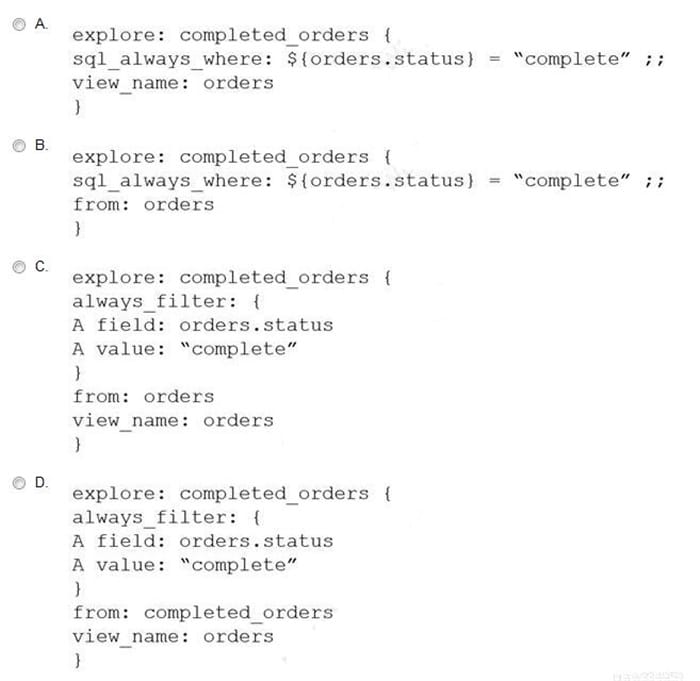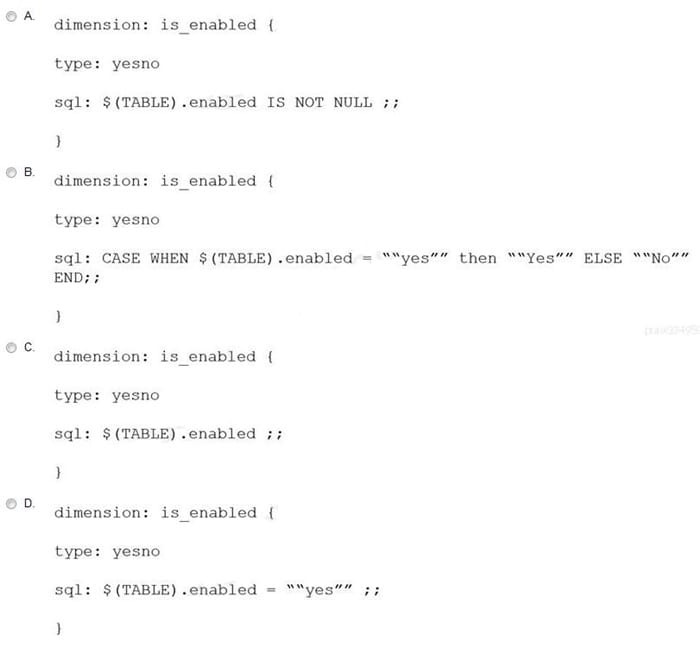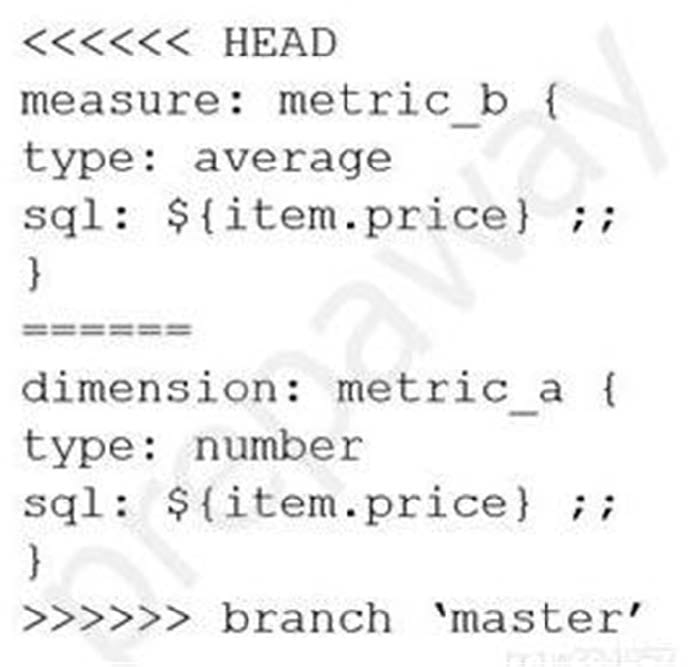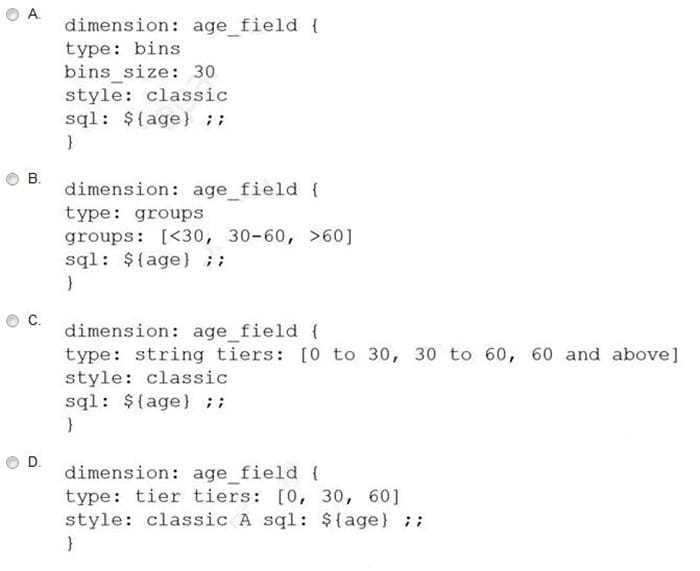LOOKML-DEVELOPER Online Practice Questions and Answers
A developer needs to add an Explore built off of the orders view, which surfaces only completed orders. An orders Explore exists that contains all order information. Fields from the orders view are also referenced in other existing views such as ${orders.fieldname}.
How should developer define a new Explore for completed orders and keep all field references working correctly?

A. Option A
B. Option B
C. Option C
D. Option D
A developer has User Specific Time Zones enabled for a Looker instance, but wants to ensure that queries run in Looker are as performant as they can be. The developer wants to add a datatype: date parameter to all dimension_group definitions without time data in a table-based view, so that time conversions don't occur for these fields.
How can the developer determine to which fields this parameter should be applied through SQL Runner?
A. Open the Explore query in SQL Runner and validate whether removing the conversion from date fields changes the results.
B. Open the Explore query in SQL Runner to determine which fields are converted.
C. Use the CAST function in SQL Runner to ensure that all underlying fields are dates and conversions are not applied.
D. Use the Describe feature in SQL Runner to determine which fields include time data.
A developer would like to add a new dimension of type: yesno for the enabled column in their users table. The column is of type: string in the database and returns yes and no values.
How should the developer define the yesno dimension?

A. Option A
B. Option B
C. Option C
D. Option D
A developer has a persistent derived table view called user_facts that contains aggregated data for each user. The developer needs to query the data from this table in another derived table view called user_region_facts.
Which strategy should the developer use to write the query for user_region_facts that will leverage the existing derived table?
A. Use ${user_facts.SQL_TABLE_NAME} to reference the user_facts derived table.
B. Copy the name of the database table in the scratch schema for the user_facts derived table.
C. Writhe the query form user_facts into a common table expression (WITH user_facts AS...).
D. Write a subquery in the FROM clause and alias with ${user_facts}.
A developer wants to create a new Explore based on the order_items view. The developer creates an
Explore in the ecommerce model file with the following definition:
explore: order_items {}
After saving and validations, the developer receives this LookML validator error:
Inaccessible view “inventory_items”, “inventory_items” is not accessible in explore” “order_items”. Check
for typos and missing joins in explore “order_items”.
What caused this error to appear?
A. A field in the order_items view references a field in the inventory_items view.
B. A field in the inventory_items view references a field in the order_items view.
C. There is an Explore named inventory_items which references the order_items view.
D. There is another Explore named order_items which references the inventory_items view.
A user reports an error message on an Explore: “Non-unique value/primary key (or sql_distinct_key), value overflow or collision when computing sum”.
What should the LookML developer check for in the joined views of the Explore?
A. The sum measure used is defined correctly.
B. A unique primary key is defined in each view.
C. Symmetric_aggregates: no is not present in the Explore definition.
D. No concatenated primary keys are used.
A developer needs to implement three persistent derived tables (PDTs) as described below.
The PDTs need to be refreshed after the daily ETL pipeline adds incremental loads to the underlying
tables.
Each PDT is built off of one underlying table in the database (one PDT per table).
The underlying tables for each PDT are updated one after the other, and a new row is added to an ETL log
table each time a table is updated.
Due to the unpredictable nature of the ETL pipeline, each PDT does not refresh at the same time from day
to day.
Each PDT takes over an hour to build, and to save on compute costs each PDT should only be refreshed
once per day.
How can the developer set up the PDTs according to these requirements?
A. Create one datagroup tied to all three PDTs that runs when the total row count across all three tables changes.
B. Create one datagroup tied to all three PDTs that parameterizes the view name for each PDT in the SQL trigger condition.
C. Create three separate datagroups tied to three PDTs that run when each corresponding table's row count changes.
D. Create three separate datagroups tied to three PDTs that run when a new row is added to the ETL log table.
A developer commits changes after adding LookML for a new measure. Upon pulling from production, the developer notices the following lines in the LookML:

A. Remove “andlt;<<<<< HEAD”, “======”, and “andgt;>>>>> branch ‘master’”
B. Remove “andlt;<<<<< HEAD”, “======”, and everything following “======”
C. Remove everything between “andlt;<<<<< HEAD” and “======”, and “andgt;>>>>> branch ‘master’”
D. Remove everything between “andlt;<<<<< HEAD” and “andgt;>>>>> branch ‘master’”
A LookML developer has a transactions view with several measures that each perform complex calculations involving multiple fields. The LookML developer creates an Explore based on the transactions view. The product team wants to perform further functions on these measures, such as SUM, AVG, MIN, MAX, and RANK. The team wants these further functions to be performed at different levels of detail: weekly, monthly, and yearly.
How can the LookML developer model these requirements and minimize the amount of code rewriting?
A. Add measures to the transactions view of type: number to apply the required functions.
B. Change the existing measures in the transactions view to dimensions, and add measures of the different required types.
C. Create a constant for each measure so it can be reused across other areas of the LookML project.
D. Create native derived tables using transactions as the explore_source.
A developer needs to build a new dimension that offers an age-based cohort representation of users. Which LookML code should the developer use to meet the requirement?

A. Option A
B. Option B
C. Option C
D. Option D
A LookML developer finishes some LookML work and commits changes in their personal development branch. The developer is asked to Pull and Merge Other Changes.
What does this indicate?
A. A change has been deployed to a shared branch.
B. A change has been committed in another developer's personal branch.
C. A change has been committed in another shared branch.
D. A change has been deployed to production.
A developer defines the following measure in the order_items view: The code must validate without errors. Which action should the developer take?

A. Join order_items and inventory_items in a derived table.
B. Join order_items and inventory_items in the same Explore.
C. Copy the cost definition from inventory_items to the order_items view file.
D. Add the following to the order_items view file: include: “inventory_items,view.lkml”
A developer has the dimensions enrollment_month and graduation_month already defined in the view. Both were created as part of dimension_groups of type: time. The developer need to use these two dimensions in the sql_start and sql_end parameters of a dimension group of type: duration.
Which LookML should be used to calculate the number of month and years between enrollment month and graduation month?

A. Option A
B. Option B
C. Option C
D. Option D
A user reports that, when a date dimension is filtered to “before now” results are returned that consistently include tomorrow. Dimension fill has been ruled out as a cause of the issue.
Which LookML parameter should be used to resolve this issue?
A. Week_start_day
B. Convert_tz
C. Datatype
D. Fiscal_month_offset
A developer is defining the users table within a view file in Looker. The users table will be available as an individual Explore and it will also be joined into other Explores, such as the products Explore. The developer needs to limit the fields visible in the products Explore without affecting the visibility of the fields in the users Explore.
How should the developer meet this requirement?
A. Use the fields parameter at the join level for the products Explore to specify which fields should be included and leave the users Explore as is.
B. Create duplicate dimensions and measures, one for the users Explore and one for the products Explore, and use the hidden parameter to modify the visibility of the fields.
C. Create two view files for the users table. One view file will have all possible fields for the users Explore, and the other will have only the fields required for the products Explore.
D. Use the hidden parameter in the users view file for the fields that should not come over to the products Explore and leave the users Explore as is.
